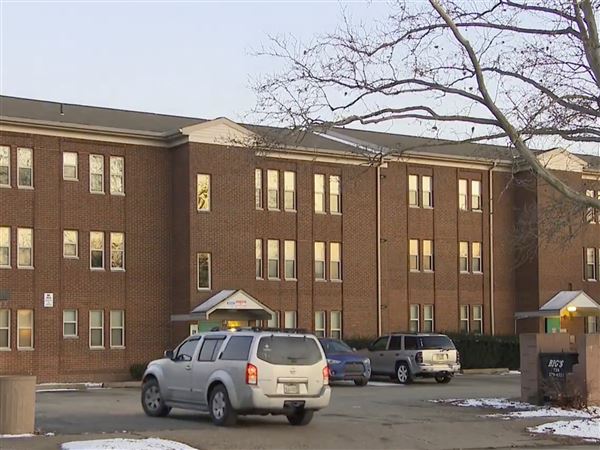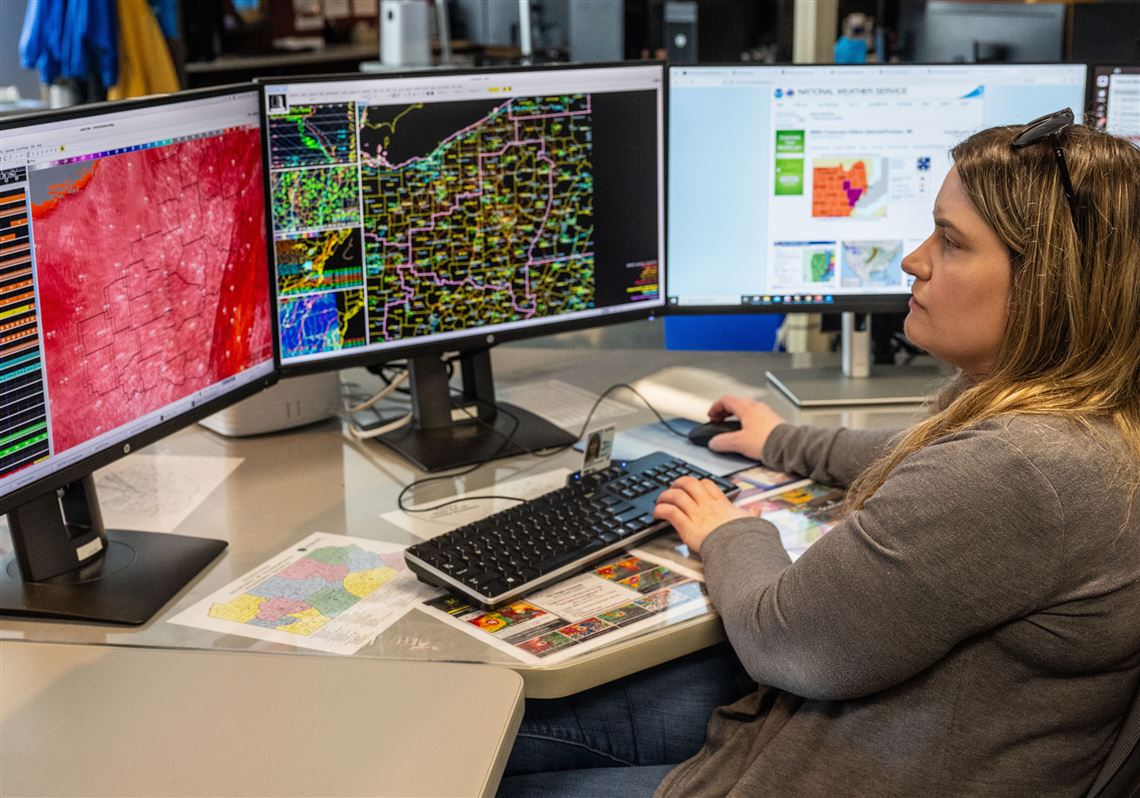The National Weather Service office in Moon was ready this week when storms and scorching heat hit the region, downing trees and power lines and sending people scrambling to find cooler air.
During severe thunderstorms such as the one Monday, weather service meteorologists constantly monitored radar, listened to police scanners and kept in touch with emergency services.
Every forecaster has a desk holding at least five computer screens that track weather patterns and show updated forecasts.
One meteorologist is tasked with monitoring flight conditions for the Federal Aviation Administration during storms. Another keeps track of the radar, and a third meteorologist updates temperature forecasts. Along a wall are larger monitors, which can be activated during storms for “situational awareness,” said meteorologist Mike Kennedy.
Lead meteorologist Shannon Hefferan said there are two to seven meteorologists in the weather center on Shafer Road at any one time, some monitoring conditions, others scouring social media for damage reports. The Pittsburgh office covers 36 counties in the Tri-State area.
“My job is doing the forecast for the next seven days,” she said. “Monitoring the threat for the excessive heat is the main thing, and the forecast for precipitation and thunderstorms.”
Every day at 7 a.m. and 7 p.m., a meteorologist releases a weather balloon that is tracked by GPS and satellites to collect such data as atmospheric pressure, temperature, dew points and wind speed. Meteorologists use the data to help with forecasts, Ms. Hefferan said.
One of her key jobs this week has been updating the extreme heat advisory that currently is in place until 8 p.m. Saturday and determining whether it should be extended.
“It's still going to be hot, so I'm going to have to collaborate … with [NWS offices elsewhere] to talk about [extending] this heat advisory to the weekend,” Ms. Hefferan said. “People [think] it's going to stop Friday, but it's not. It's going to keep going.
“They're going to want to know, like, ‘OK, I need to keep my cooling centers open into the weekend,’ because they want to know how long this is going to last. We keep in constant touch with the emergency managers, especially in the summertime, for any kind of outdoor event across any of our area.”
In the wake of the heat advisory, Pittsburgh has opened six cooling centers, and CitiParks Recreation Centers with air conditioning also are open all week. In addition, Allegheny County made another 17 cooling centers available.
High temperatures headed into the weekend are expected to be in the mid-90s with the heat index in the low 100s. The heat index, also known as the apparent temperature, is what the temperature feels like to the human body when relative humidity is combined with the air temperature.
“This has important considerations for the human body's comfort,” the weather service explains on its website. “When the body gets too hot, it begins to perspire or sweat to cool itself off. If the perspiration is not able to evaporate, the body cannot regulate its temperature.”
And that can be deadly, leading to life-threatening effects such as heat stroke.
“It should feel warmer as we close out the week,” said Mr. Kennedy.
Also contributing to the heat advisory are high nighttime temperatures, expected to be in the low-70s for the rest of the week.
“It’s the warm low temperatures and the length of the heat that’s contributing to the heat advisory,” Mr. Kennedy said.
As the region assessed storm damage this week and struggled to open roads blocked by downed trees and restore power to thousands of households, Ms. Hefferan updated the weather service’s daily briefing to include a “marginal risk” for additional severe storms that may roar into the area, in addition to the heat threat.
Her daily briefings, which are posted on the NWS website, also incorporate tips on public safety, including that a severe heat wave can cause temperatures in vehicles to skyrocket, a danger she said people don’t always heed.
“We know that heat is the No. 1 [weather-related] killer. It's a silent killer,” Ms. Hefferan said.
Concerning heat in vehicles, she said, people sometimes “don’t understand, especially people who are vulnerable, like the elderly and children. It's a heat box. It's like a greenhouse.”
As an example of her monitoring social media this week, Ms. Hefferan said some people posted Monday about “funky-shaped” clouds they spotted as the storm rolled through.
Ms. Hefferan created a graphic about the clouds, what they meant, and why people didn’t have to be worried that they had witnessed a tornado.
In fact, she said, meteorologists often rely on contributions from the public, as they can only see what’s on their radar.
“We do training for people that are interested in weather, too, because they give us storm reports,” Ms. Hefferan said. “So we want them to be informed of what things are, because we can't be the eyes of the entire area.”
First Published: June 20, 2024, 9:30 a.m.
Updated: June 20, 2024, 5:15 p.m.






















